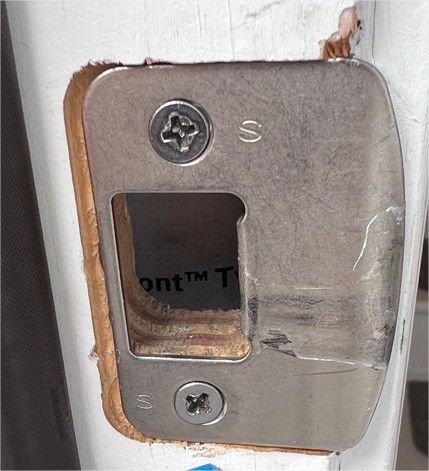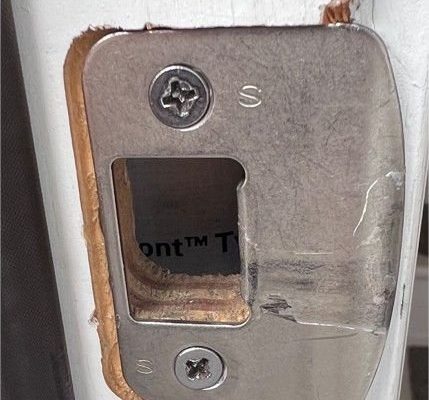
Most people don’t pay much attention to their deadbolt hardware—until something’s wrong. The strike plate tongue, especially in popular brands like Kwikset or Schlage, quietly works every time you lock up. When it starts showing wear or breaks, it’s your home’s way of sending a little SOS. And trust me, ignoring it will only lead to bigger headaches down the line.
Let’s dig into what causes this kind of damage, what those weird wear patterns can really tell you, and—more importantly—how you can stop it from happening again.
What Is the Strike Plate Tongue and Why Does It Matter?
The strike plate tongue is the bent, lip-like part of the metal plate mounted on your door frame. Its main job is simple: it catches and holds the deadbolt’s locking bolt when you turn your key or remote. Without it, the bolt would just bash into the wood and never lock into place—basically like parking your car without curb stops.
Here’s the thing: every time you lock or unlock your deadbolt, the bolt slides past that tongue. It’s a guided handshake between your door and its frame. The plate tongue has to be tough enough to take this repeated impact, but also smooth enough to help the bolt glide in and out easily. If it gets bent, chipped, or worn sharp, even fancy models like Yale or August locks can start sticking, jamming, or failing to engage.
Honestly, it’s easy to overlook because the tongue hides in plain sight—right at the edge of your door, never flashy, always working. Any visible damage here is a clear signal there’s more friction and force going on than there should be.
Common Wear Patterns: What Does Damaged Look Like?
Most damaged strike plate tongues fall into a few broad categories, each telling its own story. Not all damage is created equal, and specific patterns can clue you in on the root problem, kind of like reading the tread on worn tires.
- Rounded or Flattened Edges: This usually means the bolt isn’t lining up perfectly. Every slam or forced lock slowly shaves off the metal, wearing it flat.
- Notches or Gouges: Jagged chunks or deep scratches often come from aggressive locking, maybe when the deadbolt and strike plate are misaligned or the door sags.
- Bent or Warped Tongue: If the lip is bent outward (or inward), odds are someone’s pushed or pulled too hard, or the bolt is hitting at a bad angle every time.
Let me paint a picture: imagine trying to fit a square peg in a round hole—after a while the peg and the hole both get a little battered. The same happens here, especially if your door gets out of sync due to humidity, settling, or just plain age.
Main Causes of Strike Plate Tongue Damage
So, why does this damage happen in the first place? Most of the time, it comes down to a handful of basic mechanical issues.
Misalignment is Public Enemy
Forcing the Lock: Sometimes, you’re in a hurry, your hands are full, or you’ve got a stubborn lock. Forcing the bolt to engage with extra pressure can gouge or bend the tongue, even on heavy-duty strike plates. With electronic locks, someone might try to override the code or remote, slamming the mechanism repeatedly.
Thin or Cheap Materials: Strike plates vary a ton across brands and models. Cheaper plates from off-brands tend to be softer, with tongues that deform easily. Top-tier plates from Schlage or commercial Kwikset models usually hold up better but aren’t immune if the fit is poor.
Lack of Lubrication: Friction is sneaky. A bit of dry graphite or lock lubricant on the bolt can help, but if you skip maintenance, metal-on-metal grinding eats up the tongue quickly.
How Alignment Issues Trigger Damage
Let me explain why alignment is such a big deal—because it’s nearly always the hidden culprit. When your door or frame shifts, even by a couple of millimeters, the deadbolt starts hitting off-center. Instead of gliding smoothly, it slams or drags across the edge of the tongue.
Here’s a real-world example: I had a client with a weather-exposed door. One spring, the wood expanded just enough that the bolt started barely catching the edge of the tongue. They noticed it was getting harder to lock, and within a month, the tongue was notched and the bolt itself was starting to deform.
Why does this matter?
When alignment’s off, every lock and unlock is a slow grind. That extra force not only damages the strike plate tongue, but it can also wear out your deadbolt, the latch, and even the interior mechanism of electronic locks.
If left unchecked, you’ll be looking at major repairs instead of a simple adjustment or replacement.
Brand Differences: Are All Strike Plates Created Equal?
You might be wondering if the brand of your lock—say, Yale, Kwikset, Schlage, or an off-brand—makes a difference in how fast the strike plate tongue wears out. In short: yes, but it’s not the whole story.
- Top-tier brands: Hardware from brands like Schlage or Yale tends to use hardened steel for strike plates, which resists deformation and gouges better than cheaper alloys.
- Budget or OEM plates: Off-brand plates are often stamped from softer metal. They may look similar but will bend or wear much faster under stress.
- Electronic locks: Some smart locks use different bolt shapes or require wider tongue lips, changing how wear develops over time.
But here’s the kicker: Even the toughest strike plate can’t stand up to chronic misalignment. Fit and installation matter more than the logo on your lock. If you’re mixing a universal plate with a brand-specific deadbolt, mismatched geometry can cause weird wear, even if both parts are supposedly “compatible.”
How to Inspect and Diagnose Strike Plate Tongue Damage
If your lock feels sticky or you spot damage, it’s time for a little DIY detective work. Don’t worry—it’s easier than it sounds.
Visual Check: Open your door and take a close look at the strike plate tongue. Look for metal shavings, nickel or brass dust, bent edges, or shiny spots where the bolt rubs. Compare your plate to an online image of a new one if you’re not sure what’s normal.
Locking Test: Try locking and unlocking the deadbolt with the door open. If it’s buttery-smooth, but sticks when the door is shut, alignment is your main suspect. If it’s always rough, the plate or bolt may be damaged.
Marking Trick: Here’s a little pro tip: coat the bolt with a bit of chalk or lipstick, then close the door and lock/unlock a couple times. Open it up—you’ll see exactly where the bolt is hitting and rubbing on the tongue.
Listen for Clues: Do you hear scraping, popping, or crunching sounds? That’s the bolt grinding, not gliding, over the tongue. That sound is the start of damage—don’t ignore it.
Repairing and Preventing Strike Plate Tongue Damage
So, what can you do if your strike plate tongue is banged up? Good news: most fixes are simple if you catch the problem early.
- Realign the Strike Plate: Loosen the screws and shift the plate up, down, or sideways until the deadbolt slides in smoothly without scraping. This solves most wear issues.
- Replace Damaged Plates: Strike plates are cheap and easy to swap out. Bring your old one to the hardware store to match the shape and size.
- Upgrade for Strength: If you’ve had repeat problems, go for a heavy-duty plate with a reinforced tongue and longer screws that grab the frame—not just the trim.
- Lubricate the Mechanism: Use powdered graphite or a silicone spray to reduce friction, making each lock/unlock easier on the hardware.
And hey, regular check-ups are smart. Just like you’d inspect your car’s brakes, a quick look at your locks every few months can save a ton of hassle.
Should You DIY or Call a Locksmith?
Most strike plate issues are DIY-friendly for a careful homeowner with a screwdriver, some patience, and maybe a YouTube video. But, there are times you’ll want backup:
- Bad misalignment: If shifting the plate doesn’t help, your door frame might be warped or your hinges need shimming.
- Electronic or coded locks: If you’ve got a smart lock with pairing or sync issues, or internal bolt problems, specialized tools or reset steps may be needed.
- Recurring damage: If you’ve replaced plates multiple times, something deeper is wrong. A pro can analyze the wear pattern, check the code for fit, and suggest a real fix.
Locksmiths aren’t just for emergencies. Their troubleshooting skills and gear can save hours of frustration—and help spot problems you might miss.
How Proper Installation and Maintenance Prevent Damage
Honestly, a good install is your best defense. Starting with a correctly placed strike plate, strong screws, and a well-aligned door makes a world of difference. Even the fanciest Bluetooth or coded remote lock will struggle if the basics aren’t right.
Make it a habit:
- Check your lock’s operation seasonally, especially if you live in a climate with big temperature swings.
- Tighten loose hinges and screws to keep the door hanging squarely.
- Add a dab of lubricant to the bolt every few months, especially on smart locks that see a lot of action via remote.
- When in doubt, don’t force it—if the deadbolt won’t go, stop and check the fit.
Even universal upgrade kits—no matter the code or brand—won’t solve strike plate tongue damage if you don’t address the root mechanical issue. Prevention always beats repair.
Final Thoughts: Keep Your Locks Strong and Smooth
Dealing with a damaged deadbolt strike plate tongue is like catching a pothole forming on your favorite road. It starts small, but if you ignore it, you’re in for a bumpy ride. Most of the time, a little attention to alignment, regular maintenance, and not forcing the hardware will keep your locks feeling smooth and secure. Whether you’re using a basic Kwikset, a high-end Yale, or a smart lock with code and remote features, the basics—fit, care, and quality—matter most.
So, next time your lock feels a little off, don’t just wrestle with the key or blame your remote. Take a closer look at that tiny strike plate tongue. Fixing the problem now will save you a world of trouble later, and honestly, you’ll sleep better knowing your door’s got your back.
